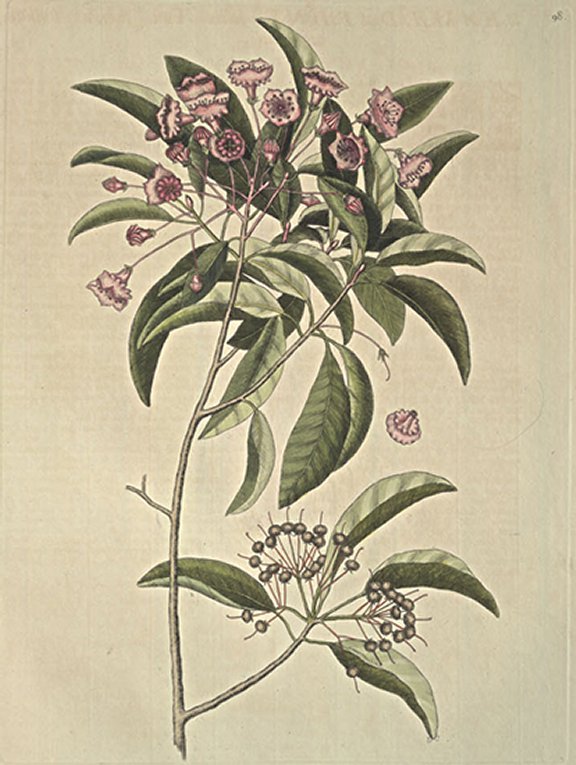Plate Number: II 98Chamaedaphne foliis Tini, floribus bullatis umbellatis This ever green Shrub rises usually to the Height of five or six Feet, and sometimes twice that Height: The Stems of some are as big as the small of a Man's Leg, though generally they are smaller, and covered with a rough brown Bark: The Wood is very close grained, heavy and hard, like Box: The Limbs in general are crooked and grow irregular, but are thick cloathed with stiff smooth Leaves, of a shining bright green, most of which are contracted, as in the Figure: The Flowers grow in Bunches on the Tops of the Branches, to Footstalks of three Inches long; they are white, stain'd with purplish red; consisting of one Leaf in Form of a Cup, divided at the Verge into five Sections; in the Middle is a Stilus, and ten Stamina, which when the Flower first opens, appear lying close to the Sides of the Cup, at equal Distances; their Apices being lodged in ten little hollow Cells, which being prominent on the Outside, appear as so many little Tubercles: The Flowers are succeeded by small round Capsulas; which when ripe open in five Parts, and discharge its small Dust like Seeds. This Plant is a Native of Carolina, Virginia, and other Parts of the Northern Continent of America, yet are not common, but are found only in particular Places: They grow on Rocks, hanging over Rivulets, and running Streams, and on the Sides of barren Hills, in a Soil the most streril, and least productive of any I ever saw. The noxious Qualities of this elegant Plant lessens that Esteem which its Beauty claims; for the Deer feed on its green Leaves with Impunity; yet when Cattle and Sheep, by severe Winters deprived of better Food, feed on the Leaves of these Plants, a great many of them die annually: They blossom in May, and continue in Flower a great Part of the Summer. As all Plants have their peculiar Beauties, 'tis difficult to assign to any one an Elegance excelling all others, yet considering the curious Structure of the Flower, and beautiful Appearance of this whole Plant; I know of no Shrub that has a better Claim to it. After several unsuccessful Attempts to propagate it from Seeds, I procured Plants of it at several Times from America, but with little better Success, for they gradually diminished, and produced no Blossoms; 'till my curious Friend Mr. Peter Collinson, excited by a View of its dryed Specimens, and Description of it, procured some Plants of it from Pensilvania, which Climate being nearer to that of England, than from whence mine came, some Bunches of Blossoms were produced in July 1740, and in 1741, in my Garden at Fulham. |